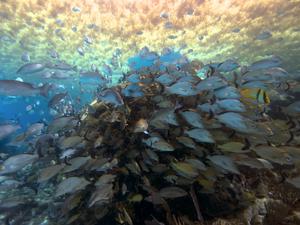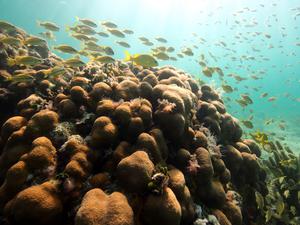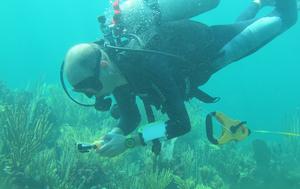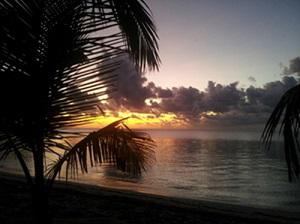Adam Suchley
We aim to evaluate the effect of Marine Protected Areas (MPAs) on coral communities by performing systematic surveys of coral reef condition within the Mexican Caribbean. We seek to relate coral condition to environmental and anthropogenic factors enabling managers to optimize the current MPA network for coral conservation.

Puerto Morelos National Park. © Lorenzo Alvarez-Filip.
Coral reefs protect shorelines, provide habitat for a diverse range of organisms, and offer huge recreational benefits. However, Caribbean reefs have deteriorated severely due to multiple stressors including overfishing, coastal development, disease, hurricanes and climate change. Marine Protected Areas (MPAs) are one of the few tools at our disposal to combat these stressors and it is imperative to understand their impact.

Orbicella annularis coral. © Lorenzo Alvarez-Filip.
MPA protection can aid reefs via a number of mechanisms. Protection of reef fishes indirectly protects corals as herbivorous fishes consume algae which compete with corals, while corallivores liberate space for coral recruits. Furthermore, MPAs regulate activities that physically damage reefs, such as careless anchor use and destructive fishing practices, and if an MPA has a terrestrial component, sediment and nutrient input can also be controlled. Although MPA efficacy for protection of fish stocks is well understood, evidence for coral communities is often contradictory.

Video-transects using a GoPro Hero action camera.
This project addresses this knowledge gap by performing a systematic investigation of coral condition under different levels of protection at a novel scale of the entire Mexican Caribbean Mesoamerican Reef. The Mesoamerican Reef is an enormous and incredibly important ecosystem of approximately 1,000 km in length spanning four countries, along which over 60 protected areas have been established. Here, we focus on coral reefs within the eight Mexican Mesoamerican Reef MPAs. By contrasting coral reef condition within and outside protected areas and between MPAs, drivers of protection success (and failure) in terms of MPA characteristics (such as age, size, level and quality of protection) and external factors such as distance from anthropogenic influences, can be understood.

Sunrise in Sian Ka’an Biosphere Reserve, Mexico.
The interpretation of the results will allow recommendations to be communicated with national park managers with the ultimate aim of optimising the MPA network for long-term habitat conservation, in addition to fish stock protection, slowing or reversing coral reef degradation, and allowing the region’s reefs to continue to provide habitat, ecosystem, shoreline protection and other services.